Abstract
Introduction:
At the moment at Medical Faculty, University of Sarajevo, simultaneously exist two systems of teaching process, the old (pre-Bologna) and Bologna process.
Goal:
To show efficiency and justification of use of Bologna process at Medical Faculty, University of Sarajevo, through the prism of actual beneficiaries of this process, students, assessment of quality of medical education, and comparison of results of the teaching process evaluation between students studying according to the Bologna process and the old system.
Materials and Methods:
The study included period from 2012 to 2014, and had prospective character. Students of final (sixth) year were included, the last three generations of pre-Bologna, and three generations of the Bologna process, which completed their studies successfully. The study included 365 students (177 under the old system and 188 under the Bologna process), who had answered prepared questionnaire.
Results:
The presence of large number of female students, in both systems is significant. There were significant differences in opinion of students regarding the quality of space for administration and labor administration, informatization of the teaching process, the opinion of the objectivity of teachers in the assessment of the examination, and on-line access to their content. (p <0.05).
Discussion:
The Bologna process, with all its guidelines, was never to the maximum implemented in the teaching faculties, mostly because of the lack of funds and infrastructure that couldn’t fully comply with all the privileges of the Bologna process.
Conclusion:
Bologna process on this principle, has brought mediocrity, of which we have tried to escape. New school year, brings, and the new Bologna process, a new curriculum, a large number of new classes, systematization of the material, with simultaneous correction necessary in one hand in teaching, and in other hand in students themselves.
Keywords: Bologna process of education, Medical Faculty, University of Sarajevo, students
1. INTRODUCTION
The quality of the teaching-learning process at the universities of Bosnia and Herzegovina and abroad depends mainly on infrastructure that includes an optimal teaching space, personnel and equipment, in accordance with existing standards and norms at the cantonal or entity level, which are required to implement adequately the educational curriculum for students of first to sixth year by Bologna concept (1).
Bosnia and Herzegovina joined the Bologna Process in Berlin, 19.09.2003. Bologna process began to be applied in Faculty of Medicine, University of Sarajevo, from the school year 2007/08 (copying Bologna process from Heidelberg University). On the university, from that moment, two school systems are taking place, the pre-Bologna (old) system and the Bologna process.
At the moment, third generation of students finishes the classes within the Bologna process. Next year, a new generation of students will continue their education under the new, reformed curriculum, with significant changes in the curriculum, in number of classes, and annual reallocation of classes. Faculty of Medicine will also introduce classes in English, which will be the first of any State colleges in biomedical disciplines, in Bosnia and Herzegovina, that will have such classes.
Bologna process, is designed as a wonderful idea, which basically consists of following items: student, on average, works 40 hours per week, total student workload consists of attending lectures, exercises and term papers, consultations, preparation for classes, projects, graduate -master work, etc., convention was introduced that 60 points is quantitative measure of the average student load for one academic year, or 30 credits in one semester, one credit corresponds to the hourly rate of 25-30 hours of student work, points are awarded for each section of the study components program (subject, exercise, module, program of study, essay, term paper, etc.), student can score points for each exam only after the examination, the points are not grades and they can’t replace them.
2. GOAL
The goals was to show efficiency and justification of the use of the Bologna process, at Faculty of Medicine, University of Sarajevo, through the prism of actual beneficiaries of this system, students, through the assessment of quality of medical education, and comparison of results of the teaching process evaluation between students studying according to the Bologna process and the old system.
3. MATERIAL AND METHODS
The study included period from 2012 to 2014, and had prospective character. Students of the final (sixth) year were included, the last three generations of pre-Bologna, and three generations of the Bologna process, which completed their studies successfully. The study included 365 students (177 under the old system and 188 under the Bologna process), who had answered prepared questionnaire. Responses on survey questions were open and closed and the majority used the Likert scale (scale 1-5) with grades: completely unsatisfied, unsatisfied, partially satisfied, mostly satisfied, completely satisfied. P-value less than 0.05 considered statistically significant, and statistical analysis was performed using SPSS v21.
4. RESULTS
Students of old system are older than students of the Bologna process, whose average age is increasing from generation to generation, given the growing number of students who repeat a year. All students of old system repeated an academic year once or several times. The presence of large number of female students, in both systems is significant (p <0.05) (Figure 1).
Figure 1.
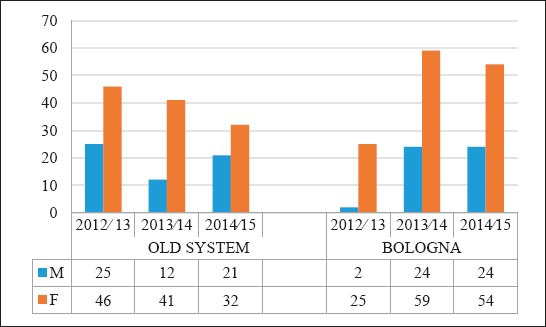
The gender distribution of subjects
There is no significant difference in student opinion on the question of the quality of physical capacity for teaching (growth of quality in the last generation), the organization of teaching, the quality of teaching, quality assessment, the level of computerization of study, and the availability and quality of literature in the library. There has been progress in the informatization and improvement in the scope and quality of the library fund. There are no significant differences in opinion of students on questions about capacity of lecture rooms, and the capacity of the premises for practical exercises. There is a significant difference in average grades for capacity of space for administrative purposes(p <0.05) (Figure 2).
Figure 2.
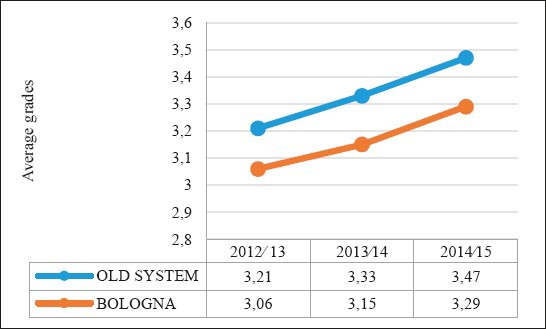
Comparation between two generations about opinion of capacity of space for administrative purposes
There are no significant differences between the grades of the capacity of space for the examinations, the quality of space for student’s social activities, the quality of student’s social standard and the quality of library space-space for learning. There has been an upward trend in quality grades through all the aforementioned questions. There are no significant differences on the assessment of the quality of implementation of the teaching process, through questions about preparedness of teachers for teaching, eloquence (a way of transferring knowledge), motivation of teachers and an interactive approach to teaching. Growing trend for students in evaluating the quality of the old system is noticed, and a declining trend for the students of the Bologna process (Figures 3,4,5).
Figure 3.
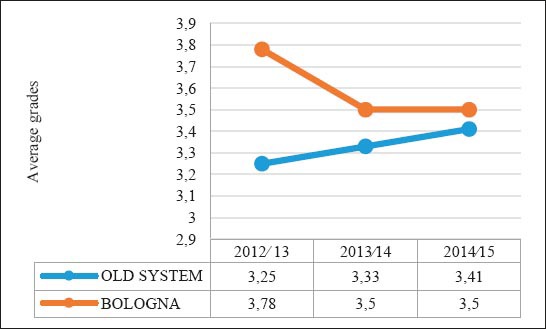
Comparation between two generations about opinion of preparedness of teachers for teaching
Figure 4.
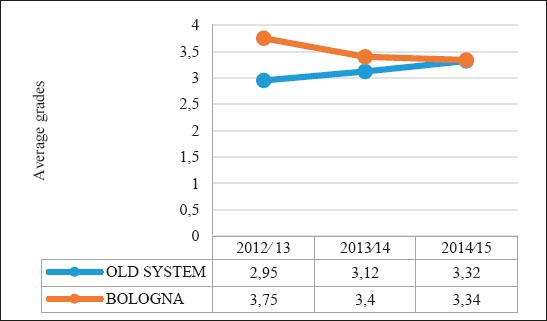
Comparation between two generations about opinion of eloquence (a way of transferring knowledge)
Figure 5.

Comparation between two generations about opinion ofan interactive approach to teaching
On the question of the objectivity of teachers in evaluating knowledge on exam, there is a significant difference in the quality assessment (p <0.05). (Figure 6).
Figure 6.

Comparation between two generations about opinion ofobjectivity of teachers in evaluating knowledge on exam
There is no significant difference in evaluating the precision of the questions and possibility to choose the examination manner (the scores are low, but showed an increasing trend from generation to generation).
There are no significant differences on the assessment of the organization of realization of teaching process- the synchronicity of the organization of teaching, the size of teaching groups, technical equipment of the laboratory/room for teaching. There is growing trend of quality in group of students of the old system, a declining trend in the quality in group of students of the Bologna process (Figures 7-9).
Figure 7.
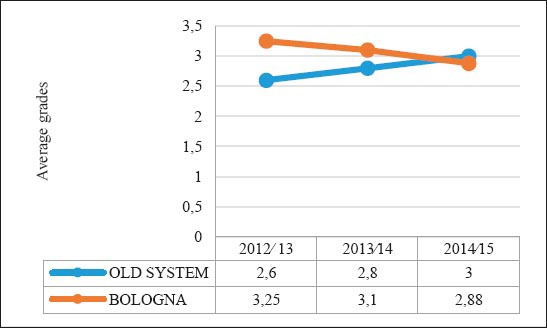
Comparation between two generations about opinion ofthe synchronicity of the organization of teaching
Figure 8.

Comparation between two generations about opinion oftechnical equipment of the laboratory/room for teaching
Figure 9.
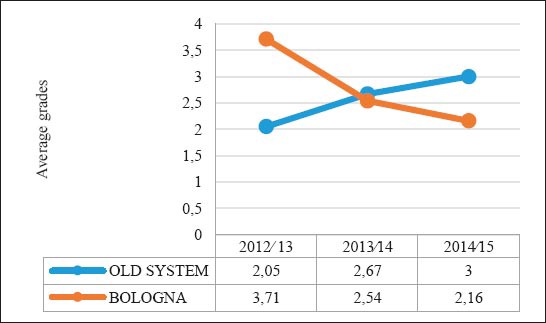
Comparation between two generations about opinion ofsize of teaching groups
When asked about the assessment of the level of computerization through the prism of the general records of enrolled students and attendance records of students, there is a significant difference in the quality assessment (Figures 10, 11). The rising trend has been observed in both groups.
Figure 10.
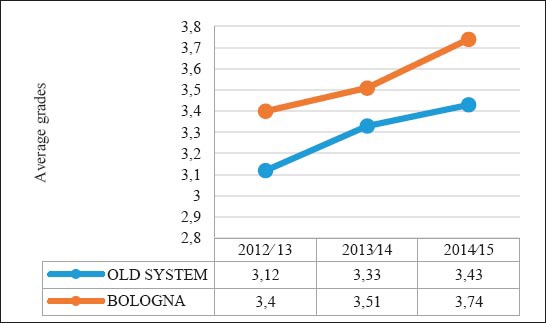
Comparation between two generations about opinion ofgeneral records of enrolled students
Figure 11.
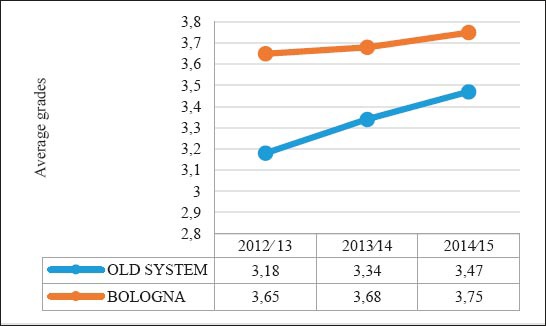
Comparation between two generations about opinion ofrecords of attendance
There is no significant difference on the assessment of the quality of questions about informatization through the prism of obtaining certificates and credentials, and method of registration for exam. The upward trend in quality scores is present in both groups of students. There is a significant difference in the quality assessment of the degree of informatization, through questions about the availability of online course content (p <0.05) (Figure 12). There are no significant differences in the assessment of the quality of availability, accessibility and quality of literature, through questions about the scope of literature in relation to educational needs, the approach to literature, and the possibility of electronic access to literature. The growth trend was observed in both groups.
Figure 12.
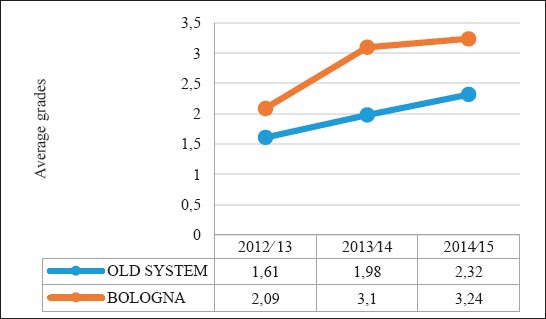
Comparation between two generations about opinion ofavailability of online course content
Taking into consideration last three generations, 59.3%, students studying under the Bologna process and 32.8% under old system, responded that assistants should pay more attention to examples. From a total number, 31% of students of Bologna process believe that exercises are poorly designed, while 8.3% of students studying under the old system feel the same (Figure 13).
Figure 13.
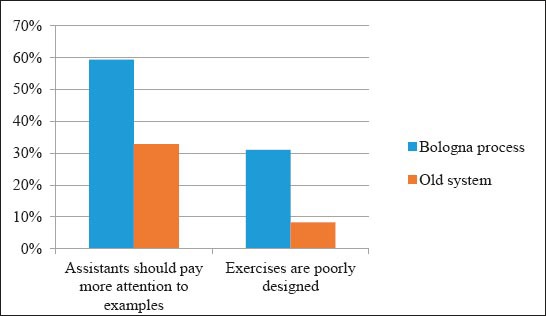
Assistants work review
Survey showed that 23.9% of students who study under Bologna process and 10.1% of students studying under the old system had the opportunity to exercise on the simulation model, 45% of students of the Bologna process had a chance to practice on a model for intubation, while 28% of students under the old system had that opportunity. Only 6,6 % of students of Bologna process practicedon the model for injections, while 11.2% of students studying under the old system had that opportunity (Figure 14).
Figure 14.
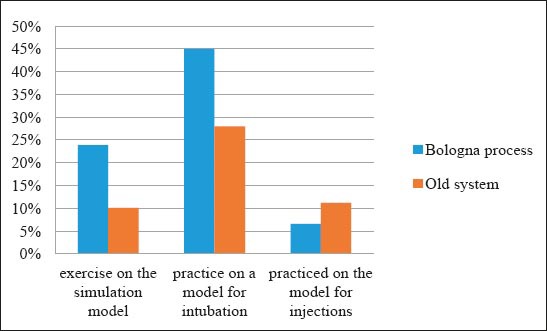
Practical skills which students were encountered with during education
About 61% of students of the Bologna process is considered that they are ready to engage in independent work, while 45% of students of the old system had the same opinion (Figure 15).
Figure 15.

Preparedness for independent work
5. DISCUSSION
The Bologna Declaration, signed in 1999 by all European Ministers of Education and currently in a phase of active implementation in Europe, specifies a three-cycle degree structure–Bachelor’s, Master’s, Doctorate–for all disciplines in Higher Education (2). At faculties of medical and related professions (pharmaceutical, dental and veterinary) in Bosnia and Herzegovina are two cycles of the Bologna process organized as a long-time study (5 and/ or 6 years). The Bologna process, with all its guidelines, never to the maximum was implemented in teaching faculties, mostly because of the lack of funds and infrastructure that could not fully comply with all the privileges of the Bologna Process. Bologna Process, designed as an idea, was supposed to raise the quality of education, and in this form can be considered quite a failure. The indisputable fact is that more students, in due time graduate university, that is certainly positive side of the process. Students are familiar with earlier clinical practice, they previously get involved in their own work clinics, students were given an interactive approach with teachers as interactive teaching, seminar groups. Students learn about the scientific research work, and they have more opportunities to deal with it through their education.
Based on the assessment of availability and quality of the teaching space, there is only significance in assessing the quality of the capacity for administration, which is based on the interests of ease the implementation of the Bologna process, both in quality of realization of the teaching process, and in methods and quality of knowledge testing of students. There is an impression that there is no understanding of Bologna process, even by the users themselves, or students. Rating the quality of implementation of the teaching process is still not sufficiently recognized by the students of the Bologna Process, which are probably busy due to time constraints, the rapid achievement of the goal in mind to fulfill their obligations. Students of the old system, are far behind in the level of informatization of their education, even in accepting new methods of knowledge transfer, and there are lower levels of participation in an interactive approach with lecturers or executors of the teaching process.
Online availability of the teaching content is mainly intended for users of the Bologna process, which puts students outside Bologna process, with earlier remnant exams, and duration of schooling, in an untenable position, and this research has confirmed that. Lecturers unconsciously, within the teaching process, create different criteria and relationships, in terms of realization of the teaching process, but also in the manner of the quality of knowledge testing of students.
General opinion of students of the old system, is that they are in a worse position, in terms of objectivity in the evaluation of teachers, including severity of the exams. The impression is that students of Bologna process take exams easier and faster, but with lower grades, in contrast to the old system.
By introduction of electronic system the work of administration has improved, it is easier for students to register for exams and to get different confirmations. The majority of students, small number of teaching staff has required use of big groups during practical teaching, and small possibility of individual work with patients. Absence of adequate number of teaching staff, excess in number of students on one teacher has influenced in decreased practical knowledge in students. The research has shown that the students opinion about teaching quality, organization of teaching process, quality of teaching staff, availability of teaching space, quality of knowledge review, level of informatization of realization teaching process, availability and accessibility of literature, isn’t different from opinion of students of old system. Three generations of students have successfully finished the study, mostly not repeating or repeating one year. Teaching staff isn’t satisfied with quality of teaching process that they are involved in, they think that the subjects are capacious, matter is capacious and it has to be handed over to the students more rapidly, and that this is simply not adequate teaching process. It seems that teaching staff hasn’t done enough on equiformity of protocol for all activities, for all subjects, for diseases and states that are obligatory in legislative system. On the other hand, students don’t have access to the teaching staff in full capacity, because of everyday duties of teaching staff, which is obvious on clinical subjects. The existence of two systems, old system and Bologna process, problems about two different teaching processes probably will be exceeded in the next period, but the differences will remain tomorrow in everyday work, especially in mutual relation. Education, even in much more developed countries than Bosnia and Herzegovina has big problems, especially in the field of biomedicine sciences. The permanent corrections are obligatory, changes in teaching process, modernization of space for lectures, practical lessons, implementing of larger number of hours for practical lessons, implementing of larger number of hours for individual students work, employment of larger number of teaching staff, and better education for teaching staff. Students and young doctors should be advised to visualize that medicine over time becomes the art of every doctor. To deal with medicine, medical research is certainly not easy. In today’s world of material, one might say that it is not profitable. What medicine gives, the act of helping people, is a huge personal satisfaction that can not be paid, or even bought. Being a doctor is not just to finish medical school. A picture of a doctor involves highly educated person who invested a lot in himself and his education. Doctors must be stable, wise, trustworthy, calm persons. They must give hope to even the most severe patients, a kind word or a simple gesture, which mean a lot to them. We expect that the new reforms of education in Faculty of Medicine, University of Sarajevo will increase the quality of education. The scale system wasn’t successful and motivating, because the students who executed their responsibilities on time, in the end have lower grades, than the students who executed that with postponement (avoiding of certain parts of exam or whole exams, with manipulation of terms).
Unavailability of teaching staff to prepare different test over and over, have conditioned the possibility of correcting and copying the questions, so on the end the knowledge examination doesn’t have too much sense. It is considered that the grades in Bologna process are not realistic, they are too low for some students, or too high for some of them. This matter will certainly have to be compared during the new reforms. It is obligatory to give the opportunity for teachers to gain better education. Teachers and staff mobility should be increased from as well to and within the Bosnia and Herzegovina. High education institutions should be privileged in terms of wide autonomy in order to decide on internal organization, staffing, new study programmes and financing, allowing students to participate and influence the organization and content of education at universities. University staff must have wide support from decision makers and political authorities and institutions in Bosnia and Herzegovina. (1) The position of medical education towards the Bologna Process is essential (3-6).
6. CONCLUSION
Bologna process has improved the quality of teaching process in plenty matters, but it has brought big number of high educated staff, that are younger than average, but also have average level of knowledge. Basically, Bologna system has brought averageness we tried to escape from. The new school year is bringing us new Bologna process, new teaching plan, a big number of new subjects, systematization of knowledge, with necessity of correction of both, teaching staff and students. We don’t expect instant solution of problems, but in the long term, this process could lead us to increasing quality, which would bring us closer to modern developed countries and their education systems. It would open a door for full incorporation in them. We shouldn’t forget that the knowledge is the most powerful weapon in the world, and it’s use is the path of prosperity and progress in community.
Footnotes
CONFLICT OF INTEREST: NONE DECLARED.
REFERENCES
- 1.Masic Quality Assessment of Medical Education at Faculty of Medicine of Sarajevo University – Comparison of Assessment Between Students in Bologna Process and Old System of Studying. Acta Inform Med. 2013;21(2):76–82. doi: 10.5455/aim.2013.21.76-82. doi: 10.5455/aim.2013.21.76-82. [DOI] [PMC free article] [PubMed] [Google Scholar]
- 2.Patrício M, Harden RM. The Bologna Process–A global vision for the future of medical education. Med Teach. 2010;32(4):305–15. doi: 10.3109/01421591003656123. doi: 10.3109/01421591003656123. [DOI] [PubMed] [Google Scholar]
- 3.Christensen L. The Bologna Process and medical education. Med Teach. 2004 Nov;26(7):625–9. doi: 10.1080/01421590400012190. doi: 10.1080/01421590400012190. [DOI] [PubMed] [Google Scholar]
- 4.Masic I. Quality assessment of Medical Education at Faculty of Medicine of Sarajevo University. Med Arh. 2012 Jun;66(3, Suppl. 1):5–10. doi: 10.5455/medarh.2012.66.s5-s10. [PubMed] [Google Scholar]
- 5.Joshi MA. Quality assurance in medical education. Indian J Pharmacol. 2012 May;44(3):285–7. doi: 10.4103/0253-7613.96295. doi: 10.4103/0253-7613.96295. [DOI] [PMC free article] [PubMed] [Google Scholar]
- 6.Dedovic-Halilbegovic G, Masic I. Ocjena edukacijskog procesa na Medicinskomm fakultetu Univerziteta u Sarajevu. Mater Sociomed. 2006;18(3):184–188. [Google Scholar]


